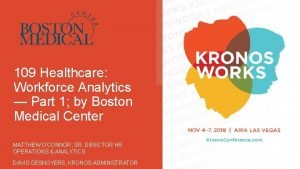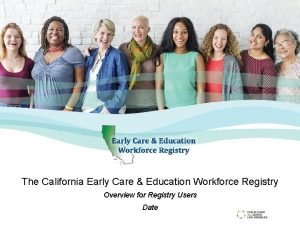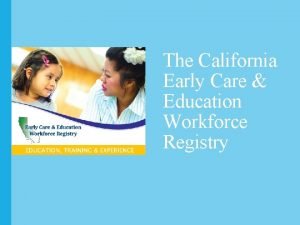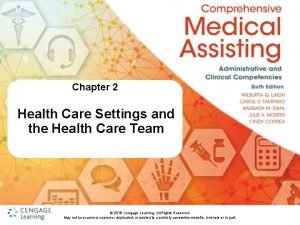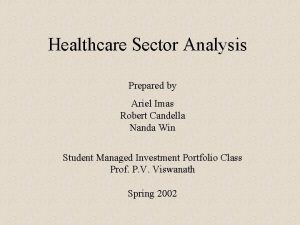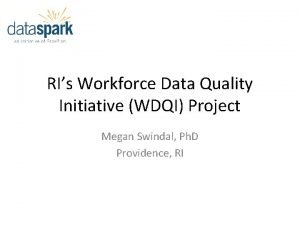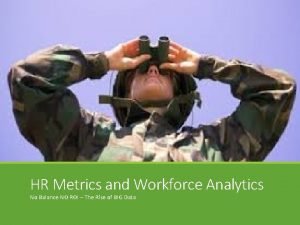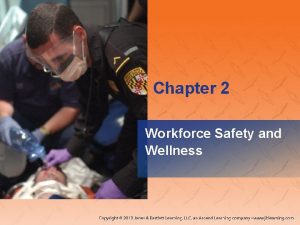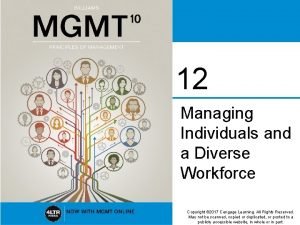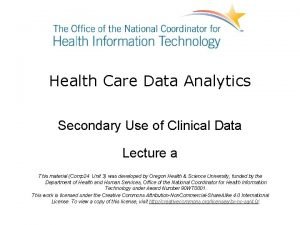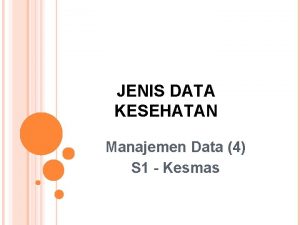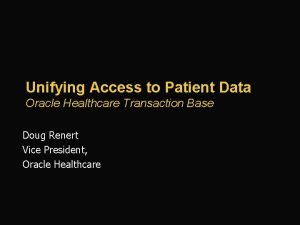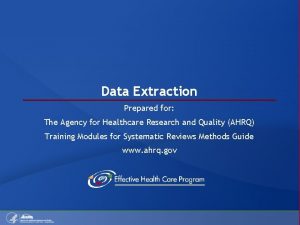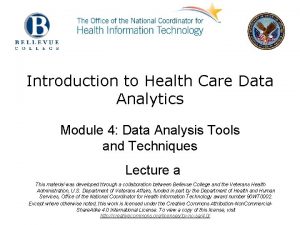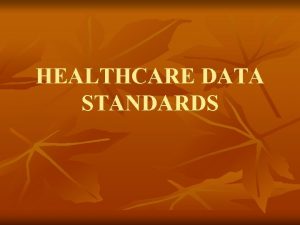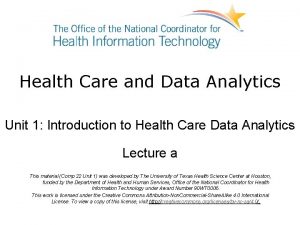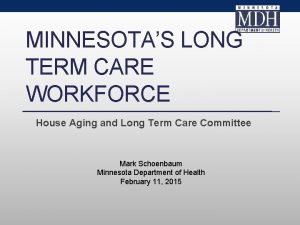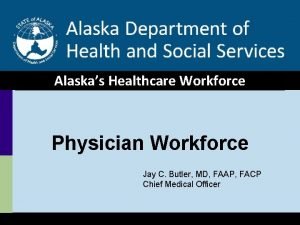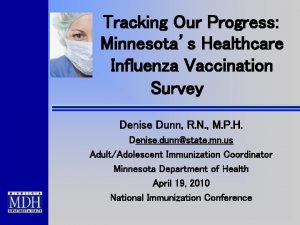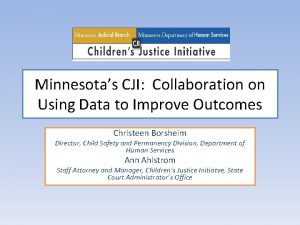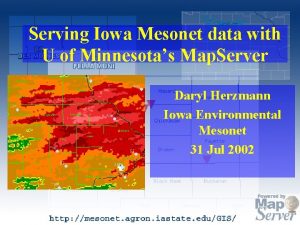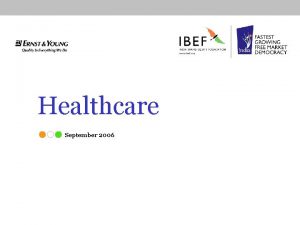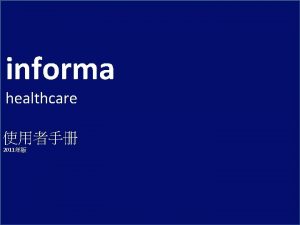Minnesotas Healthcare Workforce Data Healthcare Education and Industry


























- Slides: 26

Minnesota’s Healthcare Workforce Data Healthcare Education and Industry Partnership September 10, 2015 Teri Fritsma, Senior Workforce Analyst, MDH

Today’s discussion 1) Overview of the healthcare workforce data available in Minnesota 2) Walk through an example of how these data can be applied to a policy question 3) Update on NGA data work

What exactly is “healthcare workforce data? ” - Wages - Demographics—especially race and age - Career laddering/trajectories - Educational program completers - Rural/urban differences - Job vacancy rates - Projected workforce needs

How do YOU (or how would you) use workforce data?

Today’s discussion 1) Overview of the healthcare workforce data available in Minnesota 2) Walk through an example of how these data can be applied to a policy question 3) Update on NGA data work

Overview of available healthcare workforce data WHO? - MN Department of Health MN Hospital Association Care Providers of Minnesota MN DEED MN Department of Education MN Office of Higher Education MN Health licensing boards IPEDS (federal) “Help Wanted Online” (Private data source)

Overview of available healthcare workforce data WHAT? Where my office fits in

Overview of available healthcare workforce data HOW? Data are collected analyzed here in Minnesota, but most data sets are part of national initiatives governed partly or fully by pre-established timelines, rules, and methodologies.

How can we pull it together to say something meaningful?


Today’s discussion 1) Overview of the healthcare workforce data available in Minnesota 2) Walk through a scenario of how these data can be applied to a policy question 3) Update on NGA data work

Healthcare workforce example: fitting the pieces together Scenario: • It’s been suggested that there are not enough providers to meet the mental/behavioral health needs of residents in the northwestern part of Minnesota. • Furthermore, some say NW Minnesota providers are almost all Caucasian, perhaps ill-prepared to provide culturally competent care to those on Indian reservations. • Would expanding the U of MN Moorhead program to include a Master’s degree in social work help fill the gaps in NW MN?

Minnesota planning regions Population: 557, 666 (10%) 326, 373 (6%) 689, 638 (13%) 393, 507 (7%) 2, 950, 885 (54%) 499, 769 (9%) Population estimates are from the Minnesota State Demographic Center for 2013. Release date July 15, 2014.

Scenario—Part 1: Are there “enough” mental health providers in NW Minnesota? COUNTS Number of Residents Per every Provider Minnesota Region Psychiatrists Northwest Mpls/St. Paul Statewide Psychologists Social Workers* Marriage and Family Therapists LPCs and LPCCs Psychiatric Nurses 32, 804 3, 064 7, 435 9, 784 9, 294 16, 402 8, 756 1, 183 3, 323 2, 654 4, 431 19, 287 10, 901 1, 540 3, 533 3, 639 5, 082 17, 881 *LICSWs who provide mental/behavioral health services ONLY. Source: Healthcare Licensing Boards and Minnesota Population data

Scenario—Part 1: Are there “enough” mental health providers in NW Minnesota? MARKET DEMAND “Occupations In Demand” Indicator, 2014, Northwest Minnesota Mental Health Counselors: Substance Abuse and Behavioral Disorder Counselors: Child, Family, and School Social Workers: Mental Health and Substance Abuse Social Workers: Healthcare Social Workers: Clinical, Counseling, and School Psychologists: Source: DEED, Occupations In Demand

Scenario—Part 2: Are mental health providers in Northwest MN diverse enough? RACE Race of Mental Health Providers in Northwest Minnesota Race Psychiatrists Psychologists Social Workers Marriage and Family Therapists LPCs and LPCCs Psychiatric Nurses American Indian 0% 1% 0% 4% Asian 8% 1% 3% 0. 0% Black 0% 75% 0% 0% 0% 93% 0% 2% 0% 95% 0% 0% White Other Multi-racial No data available Source: MDH Workforce Survey, multiple years No data available 0. 0% 91% 4% 4%

Scenario—Part 3: Would adding an MSW program at U of MN-Moorhead help fill the gap? PROGRAM GRADUATES Mental Health Program Completers in Northwest Minnesota, 2012 -2013 Program Length/Award Level Program Title Up to 1 Year Over 1 & Under 4 Years General Psychology 0 0 Social Work 0 0 School Psychology 0 0 Counseling Psychology 0 0 Substance Abuse/Addiction 0 4 Counseling Source: Integrated Postsecondary Education Data Total, NW Minnesota 0 System (IPEDS) 4 4 Years Graduate Level TOTAL 171 110 0 0 26 7 171 110 26 7 0 0 4 281 33 318

Scenario—Part 3: Would adding an MSW program at U of MN-Moorhead help fill the gap? • In a survey conducted at the 2015 APRN Psychiatric Nursing conference, about half of health care providers said that they practice within 25 miles of where they completed their education. • Just over one-third of health care providers work within 25 miles of where they grew up. Source: 2015 survey conducted at the APRN Psychiatric Nursing Conference

Scenario—Part 3: Region of Education Central Northeast Northwest Twin Cities Southeast Southwest North Dakota Total Would adding an MSW program at U of MN-Moorhead help fill the gap? Region of Employment Central 51 52. 6% 0 0. 0% 66 6. 9% 0 0. 0% 4 8. 0% 3 10. 7% 146 9. 3% Northeast Northwest Twin Cities Southeast Southwest 3 3. 1% 1 25. 0% 0 0. 0% 19 2. 0% 0 0. 0% 3 6. 0% 0 0. 0% 50 3. 2% 16 22 16. 5% 22. 7% 0 3 0. 0% 75. 0% 2 0 66. 7% 0. 0% 13 789 1. 4% 82. 0% 0 1 0. 0% 100. 0% 2 6 4. 0% 12. 0% 14 6 50. 0% 21. 4% 57 1112 3. 6% 70. 5% Source: Minnesota Board of Marriage and Family Therapy 0 0. 0% 1 33. 3% 31 3. 2% 0 0. 0% 5 10. 0% 0 0. 0% 59 3. 7% 1 1. 0% 0 0. 0% 13 1. 4% 0 0. 0% 29 58. 0% 1 3. 6% 65 4. 1% Total 97 100. 0% 4 100. 0% 3 100. 0% 962 100. 0% 1 100. 0% 50 100. 0% 28 100. 0% 1578 100. 0%

Healthcare workforce example What have we learned? - Current provider counts: Low - Racial diversity: Fairly low - Market demand: Very high - Capacity to grow more: Questionable - Mobility: About half will stay in area where they trained We’re between information and knowledge

Today’s discussion 1) Overview of the healthcare workforce data available in Minnesota 2) Walk through an example of how these data can be applied to a policy question 3) Update on NGA data work

NGA data work Broad data-related goals: 1) Catalogue healthcare workforce datasets 2) Address gaps in healthcare workforce data 3) Better ways to disseminate/publicize data

NGA data work Goal 1: Catalogue healthcare workforce datasets

NGA data work Goal 2: þ Address gaps in workforce data ü Longitudinal dataset that tracks program completers through career transitions ü Addressing gaps specific to mental health workforce data ü Beginning to collect data on new and emerging models of care ü Re-designing our MDH workforce surveys to anticipate and “get ahead” of policy questions.

NGA data work Goal 3: Better ways to disseminate data How do (or would) YOU use workforce data?

Contact Information Teri Fritsma Senior Workforce Analyst Minnesota Department of Health, Office of Rural Health and Primary Care Healthcare Workforce Analysis Team Teri. Fritsma@state. mn. us (651) 201 -4004
 Telestaff bmc
Telestaff bmc Early care and education workforce registry
Early care and education workforce registry California early care and education workforce registry
California early care and education workforce registry Healthcare and the healthcare team chapter 2
Healthcare and the healthcare team chapter 2 Sports medicine meaning
Sports medicine meaning Education workforce council
Education workforce council Ewc hearing outcomes
Ewc hearing outcomes Dms for healthcare industry
Dms for healthcare industry Knowledge management systems in healthcare
Knowledge management systems in healthcare Ariel imas
Ariel imas Workforce data quality initiative
Workforce data quality initiative Rsa evaluation model
Rsa evaluation model Medical internet of things and big data in healthcare
Medical internet of things and big data in healthcare Hr metrics and workforce analytics
Hr metrics and workforce analytics Businesses often call their stores and warehouses
Businesses often call their stores and warehouses Workforce safety and wellness chapter 2
Workforce safety and wellness chapter 2 Demographic trends affecting human resource management
Demographic trends affecting human resource management Managing the aging workforce challenges and solutions
Managing the aging workforce challenges and solutions Managing individuals and a diverse workforce
Managing individuals and a diverse workforce Secondary uses of healthcare data
Secondary uses of healthcare data Healthcare data warehouse schema
Healthcare data warehouse schema Contoh data dasar pelayanan kesehatan
Contoh data dasar pelayanan kesehatan Oracle healthcare data model
Oracle healthcare data model Healthcare data extraction
Healthcare data extraction Introduction to healthcare data analytics
Introduction to healthcare data analytics Healthcare data standards
Healthcare data standards Predictive prescriptive analytics
Predictive prescriptive analytics
